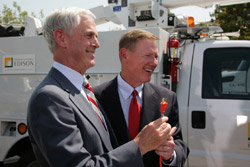Ford Motor to introduce plug-in hybrids, but lags behind rivals
Ford Motor to introduce plug-in hybrids, but lags behind rivals
mongabay.com
July 10, 2007
Monday Ford Motor Co. announced a partnership with utility Southern California Edison to test a fleet of plug-in hybrid (PHEV) vehicles in an effort to make the technology more accessible to consumers, reduce petroleum-related emissions and improve the cost-effectiveness of the nation’s electricity grid.
“The challenges of reducing greenhouse gas emissions and increasing our nation’s energy security reach across industry boundaries and unite us in a common cause,” said John E. Bryson, chairman and chief executive officer of Edison International. “Partnerships between automakers such as Ford and electric utilities such as Edison demonstrate the innovative leadership position that both companies hold in seeking and finding solutions to global and consumer problems.”

John Bryson (left), Chairman of Edison International, and Alan Mulally, President and CEO of Ford Motor Company, hold up the fuel station future plug-in hybrid vehicles will use – a standard household plug.
|
However the automaker’s reported 5-10 year time table appears to put it well behind Toyota and GM, both of which have said they plan to roll out consumer plug-in hybrids by 2010. Other firms have also shown interest in the concept, notably Google Inc., which said it would invest $10 million into the development of plug-in hybrid technology.
Environmentalists say plug-in hybrids may be the easiest next step for improving car fuel efficiency. CarCars,org, a non-profit that promotes plug-in hybrid technology, estimates that current plug-in vehicles get more than 100 miles per gallon of gas — effectively gas at under $1 per gallon. Because they rely on electricity rather than oil, plug-in hybrids generally produce less carbon dioxide and pollutants than gasoline hybrids.
Besides reducing demand for oil, plug-in hybrids are seen as an attractive way to augment the electricity grid since they generally charge at off-peak hours (night-time) and can feed the grid at peak hours (day-time) when the cars are parked. Amory B. Lovins, a renowned energy efficiency expert and cofounder of the Colorado-based Rocky Mountain Institute, estimates that a large fleet of plugins could have the capacity to displace electricity generated from new coal and nuclear plants with 6-12 times total U.S. electric generating capacity.
A recent study by the U.S. Department of Energy estimated that if every light duty car and truck in America today used plug-in hybrid technology, 73 percent of them could be plugged in and fueled by excess capacity in the electricity grid without constructing a single new power plant.














